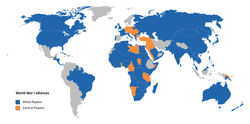The Triple Entente | |
|---|---|
| 1907–1918 | |
 Entente in blue; Central Powers in orange
Principal Entente Powers:
Associated allies and co-belligerents:
| |
| Status | Military alliance |
| Historical era | World War I |
• Established | 1907 |
• Disestablished | 1918 |
The Allies, the Entente or the Triple Entente was an international military coalition of countries led by France, the United Kingdom, Russia, the United States, Italy, and Japan against the Central Powers of Germany, Austria-Hungary, the Ottoman Empire, and Bulgaria in World War I (1914–1918).
By the end of the first decade of the 20th century, the major European powers were divided between the Triple Entente and the Triple Alliance. The Triple Entente was made up of the United Kingdom, France, and Russia. The Triple Alliance was originally composed of Germany, Austria–Hungary, and Italy, but Italy remained neutral in 1914. As the war progressed, each coalition added new members. Japan joined the Entente in 1914 and, despite proclaiming its neutrality at the beginning of the war, Italy also joined the Entente in 1915. The term "Allies" became more widely used than "Entente"[citation needed], although the United Kingdom, France, Russia, and Italy were also referred to as the Quadruple Entente and, together with Japan, as the Quintuple Entente.[1][2] The colonies administered by the countries that fought for the Allies were also part of the Entente powers such as American Philippines, Belgian Congo, British India, French Algeria, and Japanese Korea.
The United States joined near the end of the war in 1917 (the same year in which Russia withdrew from the conflict) as an "associated power" rather than an official ally. Other "associated members" included Serbia, Belgium, Montenegro, Asir, Nejd and Hasa, Portugal, Romania, Hejaz, Panama, Cuba, Greece, China, Siam, Brazil, Armenia, Luxembourg, Guatemala, Nicaragua, Costa Rica, Haiti, Liberia, and Honduras.[3] The treaties signed at the Paris Peace Conference recognized the United Kingdom, France, Italy, Japan, and the United States as "the Principal Allied and Associated Powers".[4]
Cite error: There are <ref group=lower-alpha> tags or {{efn}} templates on this page, but the references will not show without a {{reflist|group=lower-alpha}} template or {{notelist}} template (see the help page).
- ^ Torkunov, Anatoly V.; Martyn, Boris F.; Wohlforth, William C. (8 January 2020). History of International Relations and Russian Foreign Policy in the 20th Century (Volume I). Cambridge Scholars. ISBN 9781527545021.
- ^ Torkunov, Anatoly V.; Wohlforth, William C.; Martyn, Boris F. (8 January 2020). History of International Relations and Russian Foreign Policy in the 20th Century (Volume I). Cambridge Scholars. ISBN 978-1-5275-4502-1.
- ^ Karel Schelle, The First World War and the Paris Peace Agreement, GRIN Verlag, 2009, p. 24
- ^ Preamble, Treaty of Versailles Australian Treaty Series 1920 No 1